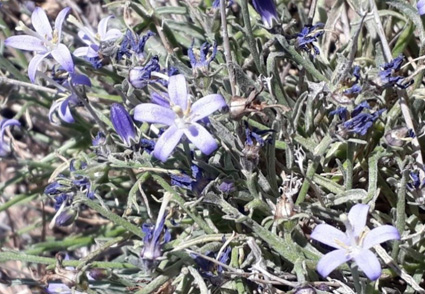Abstract
Campanula oreodoxa (Campanulaceae) is described and illustrated as a new sub-alpine species from North Khorassan province, Iran. The new species belongs to C. sect. Oreocodon based on dehiscence of the capsules with three middle pores at the base and absence of appendages between the calyx lobes. It is compared morphologically with the closely related species including C. hystricula and C. lourica. The micromorphological characters of seed coat and pollen grains of the new species are presented and compared with the chasmophytic allies in the area. Notes on distribution, habitat characterization, and the associated flora are provided. The new species is assessed as critically endangered (CR) and the conservation value of the habitats in the area is discussed.
References
Aghabeigi, F. & Assadi, M. (2008) The genus Campanula (Campanulaceae) in Iran. Edinburgh Journal of Botany 65 (3): 375–385. https://doi.org/10.1017/S0960428608004848
Aghabeigi, F. (2010) Campanula L. In: Assadi, M. et al. (Eds.) Flora of Iran, vol. 66. Research Institute of Forests and Rangelands, Tehran, pp. 5–75.
Akcin, T.A. (2009) Seed coat morphology of some Turkish Campanula (Campanulaceae) species and its systematic implications. Biologia 64 (6): 1089–1094. https://doi.org/10.2478/s11756-009-0177-5
Alçitepe, E. (2010) Studies on seed morphology of Campanula L. section Quinqueloculares (Boiss.) Phitos (Campanulaceae) in Turkey. Pakistan Journal of Botany 42: 1075–1082.
Bachman, S., Moat, J., Hill, A.W., de la Torre, J. & Scott, B. (2011) Supporting Red List threat assessment with GeoCAT: geospatial conservation assessment tool. ZooKeys 150: 117–126. https://doi.org/10.3897/zookeys.150.2109
Boissier, E. (1849) Diagnoses Plantarum Orientalium Novarum, ser. 1, vol. 11. Leipzig, 136 pp.
Borsch, T., Korotkotova, N., Raus, T., Lobim, W. & Löhne, C. (2009) The petD group II intron as a species level marker: utility for tree inference and species identification in the diverse genus Campanula (Campanulaceae). Willdenowia 39: 7–33. https://doi.org/10.3372/wi.39.39101
Damboldt, J. (1978) Campanula L. In: Davis, P.H. (Ed.) Flora of Turkey and the East Aegean Islands, vol. 6. Edinburgh University Press, Edinburgh, pp. 2–64.
Fedorov, A.A. (1957) Campanulaceae. In: Schischkin, B.K. (Ed.) Flora of the USSR, vol. 24. Academy of Sciences of the USSR, Moscow & Leningrad, pp. 126–501.
Grisebach, A. & Schenk, A. (1852) Iter hungaricum a. 1852 susceptum. Beiträge zur Systematik der ungarischen Flora. Archiv für Naturgeschichte 18: 291–362.
IUCN (2016) Guidelines for Using the IUCN Red List Categories and Criteria. Version 12. Prepared by the Standards and Petitions Subcommittee. Available from: http://www.iucnredlist.org/documents/RedListGuidelines.pdf (accessed 12 March 2020)
Khansari, E., Zarre, S., Alizadeh, K., Attar, F., Aghabeigi, F. & Salmaki, Y. (2012) Pollen morphology of Campanula (Campanulaceae) and allied genera in Iran with special focus on its systematic implication. Flora 207: 203–211. https://doi.org/10.1016/j.flora.2012.01.006
Lammers, T.G. (2007) Campanulaceae Jussieu. In: Kadereit, J.W. & Jeffrey, C. (Eds.) Kubitzki’s The Families and Genera of Vascular Plants, vol. 8. Springer, Berlin & Heidelberg, pp. 26–57.
Linnaeus, C. (1753) Species Plantarum. L. Salvius, Stockholm, 1200 pp.
Mansion, G., Parolly, G., Crowl, A.A., Mavrodiev, E., Cellinese, N., Oganesian, M., Fraunhofer, K., Kamari, G., Phitos, D., Haberle, R., Akaydi, G., Ikinci, N., Raus, T. & Borsch, T. (2012) How to handle speciose clades? Mass taxon-sampling as a strategy towards illuminating the natural history of Campanula (Campanuloideae). PLOS ONE 7 (11): e50076. https://doi.org/10.1371/journal.pone.0050076
Memariani, F., Zarrinpour, V. & Akhani, H. (2016a) A review of plant diversity, vegetation, and phytogeography of the Khorassan–Kopet-Dagh floristic province in the Irano-Turanian region (northeastern Iran – southern Turkmenistan). Phytotaxa 249 (1): 8–30. https://doi.org/10.11646/phytotaxa.249.1.4
Memariani, F., Akhani, H. & Joharchi, M.R. (2016b) Endemic plants of the Khorassan–Kopet-Dagh floristic province in the Irano-Turanian region: diversity, distribution patterns and conservation status. Phytotaxa 249 (1): 31–117. https://doi.org/10.11646/phytotaxa.249.1.5
Memariani, F., Joharchi, M.R. & Akhani, H. (2016c) Plant diversity of Ghorkhod Protected Area, NE Iran. Phytotaxa 249 (1): 118–158. https://doi.org/10.11646/phytotaxa.249.1.6
Memariani, F. (2020) The Khorassan-Kopet Dagh Mountains. In: Noroozi, J. (Ed.) Plant Biogeography and Vegetation of High Mountains of Central and South-West Asia. Springer Nature Switzerland AG, Cham, pp. 93–116. https://doi.org/10.1007/978-3-030-45212-4_3
Mittermeier, R.A., Turner, W.R., Larsen, F.W., Brooks, T.M. & Gascon, C. (2011) Global biodiversity conservation: the critical role of hotspots. In: Zachos, F.E. & Habel, J.C. (Eds.) Biodiversity Hotspots: Distribution and Protection of Conservation Priority Areas. Springer, Heidelberg, pp. 3–22. https://doi.org/10.1007/978-3-642-20992-5_1
Oganesian, M.E. (1995) Synopsis of the Caucasian Campanulaceae. Candollea 50: 275–308.
Park, J-M., Kova?i?, S., Liber, Z., Eddie, W.M. & Schneeweiss, G.M. (2006) Phylogeny and biogeography of isophyllous species of Campanula (Campanulaceae) in the Mediterranean area. Systematic Botany 31: 862–880. https://doi.org/10.1600/036364406779695924
Pau, C. & Vicioso, C. (1918) Plantas de Persia y Mesopotamia. Trabajos del Museo Nacional de Ciencias Naturales, Serie Botánica 14: 148.
POWO (2019) Plants of the World Online. Facilitated by the Royal Botanic Gardens, Kew. Published on the Internet; Available from: http://www.plantsoftheworldonline.org/ (accessed 14 October 2020)
Rechinger, K.H. (1972) Flora Iranica, vol. 90. Akademische Druck- u. Verlagsanstalt, Graz, pp. 1–329.
Rechinger, K.H. (1990) Revision of Pau’s types of plants collected by Martínez de la Escalera in Iran (1899). Anales del Jardín Botánico de Madrid 47 (2): 361–375.
Rechinger, K.H. & Schimann-Czeika, H. (1965) Flora Iranica, vol. 13. Akademische Druck- u. Verlagsanstalt, Graz, pp. 1–51.
Saeidi-Mehrvarz, S. & Kashi, S. (2015) Seed coat morphology of some species of the genus Campanula (Campanulaceae) in Iran. Wulfenia 22: 225–233.


